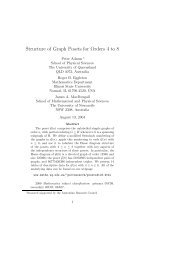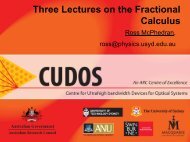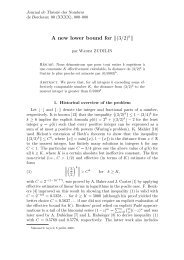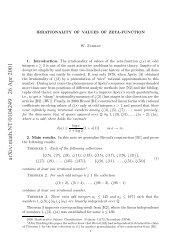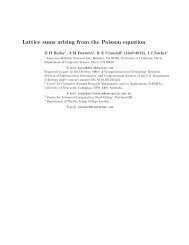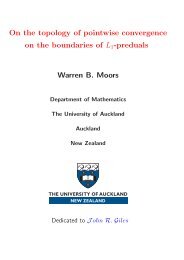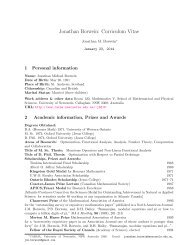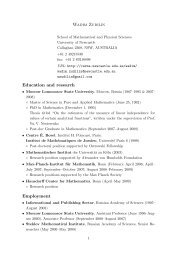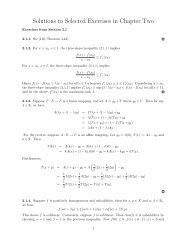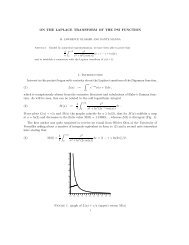QUADRATIC CONVERGENCE OF THE TANH-SINH ...
QUADRATIC CONVERGENCE OF THE TANH-SINH ...
QUADRATIC CONVERGENCE OF THE TANH-SINH ...
Create successful ePaper yourself
Turn your PDF publications into a flip-book with our unique Google optimized e-Paper software.
10 JONATHAN M. BORWEIN AND LINGYUN YEIf we denote(4.9) C(h) := 1 + 2thenand by (4.8)h ∑|n|>N(4.10)SinceÊ h F nh ≤ ∑|n|>N= π22cosh(x)cosh(π/2 sinh(x))∞∑r=1cosh(rh)cosh(π/2 sinh(rh))S n ≤ h C(h) sinh(π/2 sinh(nh))π 2 cosh(nh){hC(h) sinh (π/2 sinh(nh)) + sinh(nh)}sinh(π sinh(nh))⎛⎞⎝ ∑ hC(h) cosh(nh)cosh(π sinh(nh)/2) + ∑ sinh(2nh)⎠ .sinh(π sinh(nh))|n|>N|n|>Nis a decreasing function, we have∑n>NAlso, becausecosh(nh)cosh(π/2 sinh(nh))≤1 h= 2πh= 2πh∫ ∞N−1∫ ∞cosh(x)cosh(π/2 sinh(x)) dxπ/2 sinh(N−1)sech(u)du( π2 − arctan (sinh( )))sinh(N − 1)πwhen x is large enough,limx→∞ x ( π2 − arctan(x) )= 1 2( π) ( 1O2 − arctan (x) = Ox)thus(4.11)∑n>N( )cosh(nh)1cosh(π/2 sinh(nh)) = O eN−1e− πhAlso, the second summation in (4.10) is less than the first one , which gives(4.12) e2 = e3 = h ∑)Ê h F nh = O(C(h)e − eN−1π|n|>N4.2. Evaluation of e 1 . In order to compute e 1 = Êh,(z)Êh,(w) ̂K(z, w), we haverecourse to the results of Section 2.1. In this case, the reproducing kernel ̂K(z, w)has poles at w = i · arcsin(2n + 1) with residue π cosh(z)/ sinh(π sinh(z)) and polesat w = arcsinh(sinh(z) + (2n + 1)i) with reside −π cosh(z)/ sinh(π sinh(z)). Sincewe are dealing with real functions, ̂K(z, w) = ̂K(z, w), as a function of w, satisfiesthe conditions of Lemmas 2.3 and 2.4, if we take α ≤ i arcsin(1).



